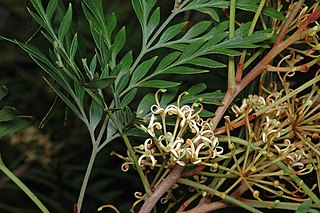
Eucryphia is a small genus of trees and large shrubs native to the south temperate regions of South America and coastal eastern Australia, mainly Tasmania. Sometimes placed in a family of their own, the Eucryphiaceae, more recent classifications place them in the Cunoniaceae. There are seven species, two in South America and five in Australia, and several named hybrids.

Austromuellera is a genus of only two known species of medium-sized trees, constituting part of the plant family Proteaceae. They are both endemic to three restricted areas of the wet tropics rainforests of north-eastern Queensland, Australia. The genus was named in 1930 in honour of Ferdinand von Mueller by Cyril T. White. They lie within the tribe Banksieae within the family Proteaceae, their closest relatives the genera Musgravea and Banksia.

Musgravea is a genus of rainforest tree from north-eastern Queensland.

Cryptocarya triplinervis is a rainforest tree growing in eastern Australia. Common names include the three veined laurel, three veined cryptocarya and the brown laurel.

Stenocarpus cryptocarpus, commonly known as the giant-leaved stenocarpus, is a species of flowering plant in the family Proteaceae and is endemic to north Queensland. It is a tree with buttress roots at the base, simple, mostly elliptical adult leaves, groups of cream-coloured flowers and narrow oblong follicles.

Eidothea zoexylocarya is a species of tall rainforest trees endemic to north-eastern Queensland, Australia and constituting part of the plant family Proteaceae. In European–Australian science, these trees were only recognised in recent decades, first from the slopes of Mount Bartle Frere, the Queensland mountain which reaches the highest altitude. In 1995, scientific descriptions of the trees, as this genus and type species, were published for the first time by Andrew W. Douglas and Bernie Hyland. The species name refers to the almost identical fossil fruit Xylocaryon lockiiF.Muell., from Ballarat, southern Australia, still extant in this north-eastern Australian species.

Syzygium cormiflorum, commonly known as the bumpy satinash, is a species of Syzygium tree endemic to Queensland in northeastern Australia.
Stockwellia is a monotypic genus in the flowering plant family Myrtaceae. The sole species in the genus, Stockwellia quadrifida, is endemic to Queensland.
Hollandaea is a small genus of plants in the family Proteaceae containing four species of Australian rainforest trees. All four species are endemic to restricted areas of the Wet Tropics of northeast Queensland.

Lasjia is a genus of five species of trees of the family Proteaceae. Three species grow naturally in northeastern Queensland, Australia and two species in Sulawesi, Indonesia. Descriptively they are the tropical or northern macadamia trees group. Lasjia species characteristically branched compound inflorescences differentiate them from the Macadamia species, of Australia, which have characteristically unbranched compound inflorescences and only grow naturally about 1,000 km (620 mi) further to the south, in southern and central eastern Queensland and in northeastern New South Wales.

Eucryphia wilkiei is a species of rainforest shrubs endemic to restricted areas of cloud forests on mountain tops in the Wet Tropics region of northeastern Queensland, Australia. As of November 2013, botanists classify Eucryphia in the family Cunoniaceae.

Aceratium ferrugineum is a species of medium-sized trees, commonly known as rusty carabeen, constituting part of the plant family Elaeocarpaceae. They are endemic to the Wet Tropics rainforests of northeastern Queensland, Australia.

Licuala ramsayi is a species of plant in the family Arecaceae; its common name is the Queensland or Australian fan palm. Two varieties are recognised: Licuala ramsayi var. ramsayi, and Licuala ramsayi var. tuckeri.

Stenocarpus davallioides, commonly known as the fern-leaved stenocarpus, is a species of flowering plant in the family Proteaceae and is endemic to north Queensland. It is a tree with simple or pinnate adult leaves, groups of creamy-green flowers and narrow oblong follicles.
Xanthostemon formosus is a species of tree in the myrtle family Myrtaceae that is endemic to north-eastern Queensland, Australia.
Buckinghamia ferruginiflora, also known as Noah's oak or spotted oak, is a species of rainforest tree in the protea family, one of two in the genus that is endemic to the Wet Tropics of Queensland, north-eastern Australia. Although the tree's differences from its congener had been known since the 1970s, it was only formally described by Donald Foreman and Bernard Hyland in 1988 in the journal Muelleria.

Lasjia grandis, also known as the satin silky oak or Barong nut, is a species of forest tree in the protea family that is endemic to north-eastern Queensland, Australia. Its conservation status is considered to be Vulnerable under Queensland's Nature Conservation Act 1992.
Lasjia whelanii, also known as Whelan's silky oak, Whelan's nut oak or Whelan's macadamia, is a species of large forest tree in the protea family that is endemic to north-eastern Queensland, Australia.
Typhonium peltandroides is a species of plant in the arum family that is endemic to Australia.
Toechima monticola, also known as mountain tamarind, is a species of plant in the lychee family that is endemic to Australia.











